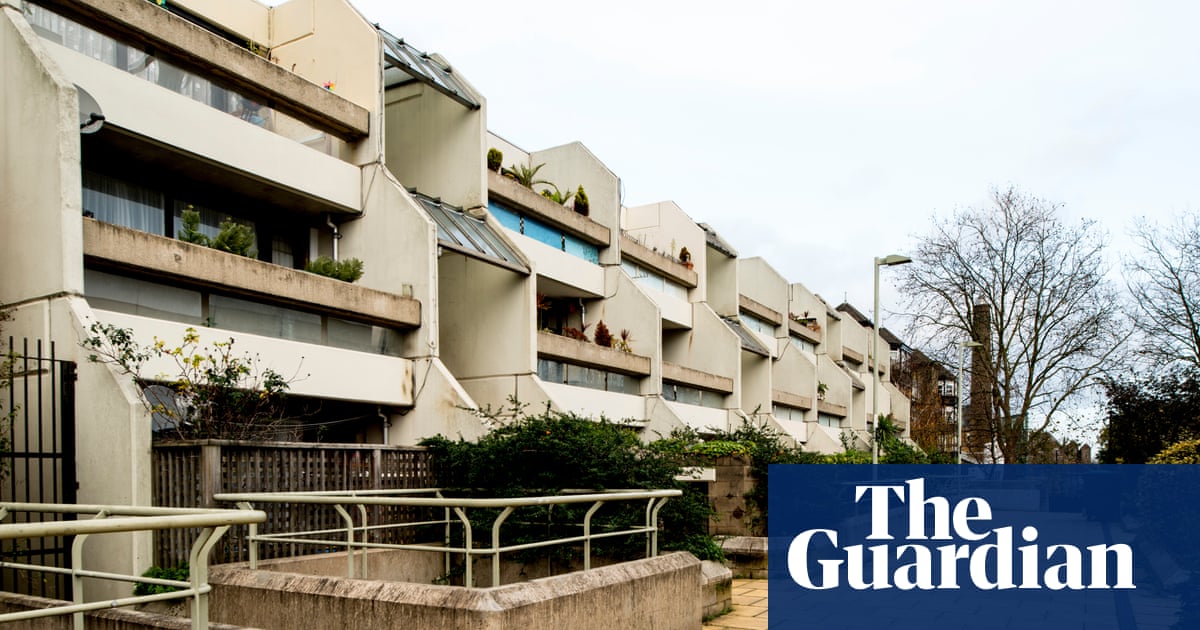
Not all social housing in the 1960s was about tower blocks. High-rise buildings were unpopular with tenants, lifts were costly and broke down, and the surrounding lawns were hard to maintain. Moreover, on the slopes around Hampstead Heath in London, towers would have blocked views towards St Paul’s Cathedral. This area became part of the newly created borough of Camden in 1965 and a visionary new chief architect, Sydney Cook, assembled a bright team of assistants to find an alternative form of housing. One of these young architects was Peter Tábori, who has died aged 83. The Whittington estate which he designed, originally known as Highgate New Town, exemplified a solution that was both innovative and successful.
Camden had identified an area of semi-derelict Victorian housing for redevelopment next to Highgate’s east cemetery, where Karl Marx is buried. Tábori realised that, on such a steep hillside, lines of flats and maisonettes could be stacked one above the other and entered from a common entrance at mid-level on the uphill side. Car parking could be set into the hill between these terraces and decked over with pedestrian walkways and children’s playgrounds.
He was inspired by medieval Italian hill towns and an internationally regarded scheme near Berne by the Swiss architects Atelier 5, but the greatest impression is of generous, humane spaces. The scheme was designed in 1968-70 but not completed until 1979 after the original contractors went bust.
The concept fitted perfectly with Cook’s own ideas and Tábori was a natural addition to the team. Other assistants working on similar solutions went on to greater recognition: Neave Brown’s complex terraces at Fleet Road (now Dunboyne Road) and Alexandra Road are listed, as are Gordon Benson and Alan Forsyth’s mainly two-storey houses on a steep slope at Branch Hill, Hampstead.
Together the group established a distinctive style for Camden’s best social housing using crisp white concrete, densely packed but relatively low-rise. Tábori’s Highgate New Town had the benefit of simplicity, in the design of the terraces and in his determination that public and private spaces should be clearly separated. This last avoided the problems faced by estates where indeterminate space led to vandalism. Mark Swenarton’s book Cook’s Camden (2017), to which Tábori generously contributed, records the inspiring story.
Highgate New Town was finely finished, the external concrete contrasting with handsome internal joinery. Cook claimed that “the quality of [Tábori’s] work isn’t just double site capacity at low rise, or all the higher standards, but that he did it all below yardstick”, the restrictive budget code imposed by governments at the time. In fact, Camden’s fine housing was made possible by its high domestic rates income and other London boroughs could not match its quality. Many of Tábori’s maisonettes remain tenanted, but those sold under “right-to-buy” legislation now fetch eye-watering prices.
Tábori went on to design a second scheme in 1971, Oakshott Court, Polygon Road, with three L-shaped terraces, but he was disappointed by a decision made in 1974 to use brick, apparently in deference to its location near St Pancras Station. A smaller scheme of 15 flats on the corner of Mill Lane and Solent Road followed in 1973 after Cook’s retirement, including four wheelchair-accessible units and five for elderly people. He also worked on a visionary programme with the architects/engineers Arup Associates for building over the main railway tracks that run through Camden, an attempt to gain space in the overcrowded borough.
He was born Peter Stroh in Budapest, the son of Istvan Stroh, a professor of mathematics, and his wife Erzsebét (nee Szanto), a former opera singer. She subsequently married Michael Tábori, an economist whose father had died at Auschwitz. Both men had been imprisoned by the communist government and following the 1956 uprising in Budapest, Peter too was arrested. On his release in December 1956 he, Erzsebét and Michael emigrated to London via Vienna, along with other members of Michael’s family. Thenceforth Tábori used his stepfather’s surname and adopted it formally on becoming a British citizen in 1966.
Tábori learned English and technical drawing with an architect, Cecil Epril, and in 1958 entered Regent Street Polytechnic (now the University of Westminster). His tutors included Richard Rogers, who inspired his interest in mass housing, and who himself designed an (unbuilt) hillside scheme in Croydon inspired by Atelier 5. Tábori assisted on Rogers’s first built house, Creekvean, with Su Rogers and Norman Foster.
Tábori also spent two years working for Ernö Goldfinger, the Hungarian-born architect immortalised by Ian Fleming, before completing his qualifications. The final external examiner was Denys Lasdun, who gave him a job assisting on the University of East Anglia, another hillside building with a stepped section where he learned about concrete techniques. However, when in 1967 the chance came to work for Cook and develop his own housing interests, Tábori seized the opportunity.
He left the borough in 1984 and formed a private practice with John Green and Bob Winning, working mainly in Hamburg, Toulouse and Soweto.
Tábori married Angelika Schiel, a model, in 1962. They had three sons, Kris, Michael and Gabor, but divorced in about 1980, and Angelika, who became an upholsterer, died in 2016. Peter had a fourth son, Tom, in 1984, with Anne Saville, a welfare adviser at the charity Gingerbread, but the couple later separated. He is survived by his sons.
Peter Tábori (Peter Stroh), architect, born 15 January 1940; died 23 February 2023












